Home
Introduction
History
Blue Steel
Tornado RB199

Vulcan B1 XA903 - Olympus 593 Trials
The Olympus 593, designed for use in Concorde was a twin spool augmented turbojet. Developed by BED and SNECMA, the Olympus 593 was civil variant derived from the Olympus 320 designed for the BAC TSR2. BED was responsible for the engine as a gas generator, and SNECMA had authority for the entire exhaust system. Development potential was to be about 40,000lb thrust. The engine comprised of a seven stage LP compressor, seven stage HP compressor, cannular combustor with eight flame tubes, single stage HP and LP turbines, simple single-gutter afterburner, cascade-type thrust reverser, multi-lobe retractable noise suppressor, multi-flap independently variable primary and secondary nozzles. Mass flow was 450lb/sec; pressure ratio 9.3:1 length (flange to flange) 148.4in; (intake to exhaust nozzle) approx 280in; inlet diameter 47.85in; weight 5,814lb.
On November 5, 1965, three weeks ahead of the contractual deadline, the Olympus 593B made its first bench run in Bristol. Back in France, SNECMA started initial tests of the variable nozzles in June 1966 at Melun-Villaroche. Three months later, flight tests started on XA903. The first version of the engine soon delivered thrust of 34,650 lb. The results of initial afterburner tests also met expectations, boosting thrust to 37,180 lb. This performance met the requirements of the aircraft manufacturers.
XA903 is being restored to as it was when testing the Olympus 593 engine, which was installed as one half of a Concorde nacelle. This was attached underneath the bomb-bay space. The weight of the Olympus 593 engine and the ancillary equipment that came with it meant that every landing was above the maximum landing weight specified in the pilot notes. The max landing weight was specified as 109,000 lb, but XA903s landing weight was always between 125 130,000 lb. Because of the under-slung engine, every landing had to be made in a fairly flat attitude to prevent the engine nacelle from scraping the runway. It therefore wasnt possible to raise the nose and use the large wing area for aerodynamic braking. Landings were made at a threshold speed of around 130 knots and the braking parachute was streamed on every landing. The nosewheel leg was from a Mk2 Vulcan. This was fitted because it was shorter than the Mk1 leg and thus avoided the 593B tail cone scraping the runway.
The bomb bay space was used for addition fuel tanks that were used to supply the 593 engine, and for a water tank that was used as part of the engine tests. The bomb bay held 400 gallons of fuel, stored in two tanks. These could be refilled from the aircrafts fuel tanks; teed off from the port side of the aircrafts cross-feed gallery. This gave 903 a fuel capacity of its normal 9382 gallons, plus 400 gallons in the bomb bay tanks, giving a total of 9782 gallons. The 593 with reheat used 5000 gallons per hour. The maximum fuel flow from the aircraft into the two tanks was 3500 gallons/hr. This meant that there was only sufficient fuel to run the 593 with reheat for about 15 minutes. (The RB199 had a maximum demand of 6000 gall/hr, allowing only 10 mins duration). Fuel could not be pumped back into the aircrafts fuel tanks from the bomb bay tanks.
One of the key functions of the test flights was to gather data from the engine for later analysis. As a result, a vast amount of sensors were fitted to the engine to allow the signals to be monitored and recorded for later analysis. In order to get the signals back into the cockpit and cabin, which was a pressurised section, an external wiring loom was fitted down the port side of the aircraft, allowing the signals to enter the radome for processing and presentation to the cabin area through the front pressure bulkhead.
In order to reduce the number of wires returning to the cabin, many of the pressure signals were multiplexed onto a single transducer, thus requiring only two wires for those signals. This was performed by devices called scanivalves (scanning valves), which allowed the measurement of 48 separate pressure measurements onto a single transducer. Signal processing comprised of signal conditioning equipment in the bomb bay and a digital data recorder DDR600 which was located in the radome.
The radome was modified to take the "T" shaped digital data recorder, weighing 600lb, which converted the analogue electrical signals from transducers (instrumentation) dotted all over the Olympus 593B engine and the aircraft, and recorded them in selected bursts onto a 1/2 inch magnetic tape in the cockpit. Because there was a large array of transducers measuring temperatures, pressures, positions etc, the DDR provided an analogue to digital conversion of the signals, then enabled spot measurements to be read in a switchable mode, using the scanivalves. So instead of continuous measurements, the DDR read each parameter in turn for a brief period and sent the digital signal to the tape - all 600 of them. The DDR600 tape recorder was a reel-to-reel recorder using 3M 1/2 inch by 1800 ft magnetic tape, located close to the rear desk, but behind them.
Also, in roughly the same position was located a separate 14 track 1 inch magnetic tape BS768 reel-to-reel recorder for measuring continuous signals for noise, vibration, engine speeds and rotating stall cell, using 3M 1 inch by 1800 ft magnetic tape. The recorders were large and highly visible and were operated with their lids off so that one of the rear desk crew could keep an eye on them, in case they stopped working or jammed. A great deal of reliance was being placed upon these recorders, because the bulk of the testing results were being channelled into them.
For example, the DDR600 was recording the "life history" every minute of six scanivalve devices, each with forty-eight ports of pressure, that's about 288 separate parameters from the Olympus 593B engine. Of course, besides this were scores of temperature measurements, mostly from Nickel-Chrome/Nickel-Aluminium thermocouples mounted within the same engine. In order to validate these measurements against test conditions, the DDR600 also recorded aircraft speed, altitude and engine speeds (LP and HP compressors), which were all digitised by various signal-conditioning units.
The Olympus 593 test flights had a crew of five. The Captain flew the aircraft from the left hand seat. The co-pilot was the engine project pilot. He had the controls and instrumentation for the test engine. Ignition of the 593 was controlled from the relight button on the pilots throttle lever.
The rear cabin was totally unique to this aircraft, being designed specifically for the 593 trials. A large instrument panel that contained over 100 instruments and indicators was installed on the starboard side of the rear desk. This primarily monitored temperatures and pressures at various stages of the engine. This panel has now been re-produced fairly authentically, along with some of the switches used for applying hydraulic & electrical loads, and also for introducing failure scenarios.
The two flight test engineers, who occupied the Navigator Radar and Navigator Plotter positions, could both see the panel but had their own individual responsibilities. The Nav Plotter controlled the instrument recorders, and kept the flight log for post-flight analysis. The Nav Radar acted as Test Controller, deciding with the project pilot the sequence of tests and in addition controlled hydraulic and electrical loads that could be applied to the test engine. He also kept a general flight test log. The fifth crewmember was the Air Electrical Officer, who carried out limited navigational duties using directional systems (ADF and TACAN), and also looked after the aircraft's electrical systems. This was an extremely important duty, as the Vulcan B. Mk 1 was an all-electric DC (direct current) aircraft, and several B1s had been lost due to electrical problems.
Based on the pilot notes for XA903, it would appear that the following were inoperative, or removed:
The biggest obstacle to the restoration of 903 is the lack of information. At present there is virtually no documented information or pictures of the cabin or cockpit areas. This is preventing progress in restoring it back to its 593 test days authentically. Any information, no matter how trivial, would be most welcome, and may be instrumental in restoring this nose section to a standard befitting an aircraft with such a fantastic history. 'With XA903 being retired from the Blue Steel programme, the
modifications to the aircraft to permit carriage of a partially-recessed
stand-off weapon were such as to preclude its use on any other MoD trial.
It was therefore the ideal choice of vehicle when a requirement arose for
an aircraft to be used as a flying test bed for the Concorde powerplant,
and it was so allocated in December 1963. It was delivered to Bristol
Siddeley's (now Rolls-Royce) flight test facility at Filton Airfield,
adjacent to the Patchway works, on 3rd January 1964. 'Concorde is powered by four Olympus 593 reheated turbojets. These
are developed from Olympus 320 for the TSR2, and were considerably
improved in the process. In turn the Olympus 320 can trace its origins
back to the Olympus 301 which powered the later versions of the Vulcan B.
Mk 2, so in fitting an Olympus 593 to a Vulcan B Mk 1, we were keeping it
in the family, so to speak. 'A simulation of the Concorde intake's central splitter plate
projected forward of the intake plane on the starboard side. The moveable
front ramp, which on Concorde is used to control the position of the
intake shock waves during supersonic flight was used on the Vulcan to
close off the intake for take-off and landing, thereby preventing any
engine compressor damage from foreign object ingestion. An auxiliary
intake door, designed to permit extra air into the engines at low speeds
or spill excess air from the intake at high speeds, or if the engine was
shut down, was also fitted. In theory therefore the installation was
representative of both a No. 1 and No. 2 intake. 'The first flight was to consist of a take-off and climb straight
ahead to 10,000 feet, with the intake ramp closed, where the aircraft
handling would be checked at high and low airspeed. Then the climb was to
be continued at 250 knots to 30,000 feet where the intake ramp was to be
opened, thus allowing the engine to 'windmill'. The aircraft handling
would then be checked at low airspeed and high Mach Number. However in the
climb, at about 27,000 feet, the ramp opened of its own accord, and a very
heavy divergent vertical oscillation set in on the aircraft, caused by air
spillage from the Olympus 593 intake, which did not stop until the Vulcan
had slowed to below 200 knots. The ramp could not be closed using the
normal controls, so the landing had to be made with the risk of foreign
object damage to the compressor. Fortunately there was none, the
installation was cleared on the second flight on the Friday, and we
finally got to the show on the Saturday and Sunday. 'Because of doubts about the effect of the ventral test engine
nacelle on the escape trajectories of the rear crew, dummy drops were made
over the Larkhill bombing range on 1st October 1966 from a height of 2000
feet and an airspeed of 170 knots. Comparison with the escape trajectories
from service Vulcan's showed no discernible difference, with the possible
exception that the second parachute failed to open, and a very expensive
dummy was written off. This exercise was mounted with the aid of the
Airborne Trials Unit, based at Boscombe Down, and they were very upset
with the Bristol Flight Test Department, until it was found that an
incorrectly set barostat had been fitted to the parachute release
mechanism. 'The aircraft could be comfortably flown on the thrust from the
Olympus 593 alone. The main engines were never shut down, however, as they
provided the electrical power necessary to operate the flying controls and
other services. The Vulcan B. Mk 1 had quite substantial batteries, to be
used in the event of a total failure of the generating system, but we
never counted on more that 10 to 11 minutes of battery time - enough to
abandon the aircraft, but not to get back on the ground. So we never
deliberately switched off the generators. 'Most Vulcan test flights were accompanied by a chase aircraft,
usually a Folland Gnat T. Mk 1. Because the endurance of the Gnat was
short, 45 minutes as opposed to the Vulcan's two hours plus, the Gnat did
not takeoff with the Vulcan, but was cleared for flight and kept on the
ground. When the Vulcan approached that part of the test programme that
required external observation, the Gnat was scrambled. ATC would vector
the chase to the target aircraft in a very short time, although on one
occasion ATC inadvertently vectored the Gnat to an RAF Vulcan, eliciting
from the pilot the comment, 'Nice intercept but the wrong Vulcan, this
one's camouflaged'. Sitting in the back seat of the Gnat ten feet below
and perhaps twenty feet behind the Vulcan, seeing a huge white delta
apparently hovering there in front of us, was an unforgettable
experience. 'The weight of the Olympus installation plus test gear was such
that XA903, at what we regarded as minimum fuel, was above the normal
Vulcan B. Mk 1 maximum landing weight. Every landing was thus made in a
fairly flat attitude and the
braking parachute was streamed on every landing. This technique
necessarily caused a high turnover in brake parachutes, with the Safety
Equipment section on occasions re-packing them like mad, but was
inevitable consequence of the design. 'On landing after the 219th and final Olympus 593 test flight on
21st July 1971, the brake parachute failed to deploy when streamed, and
also failed to jettison. The Vulcan made several circuits of Filton with
the parachute trailing in shreds behind it, before the 'chute finally fell
away. This time however there was no brake fire on landing. During the 219
test flights, 417 flying hours were accumulated which included 248 engine
test hours in flight.'
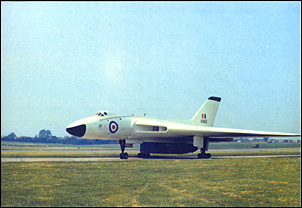
![]() Alan Baxter was Rolls Royce's Chief Flight
Test Engineer at the Filton Works in Bristol. Here he looks back to his
early days with the old Bristol Siddeley Company. This report takes up the
story of XA903.
Alan Baxter was Rolls Royce's Chief Flight
Test Engineer at the Filton Works in Bristol. Here he looks back to his
early days with the old Bristol Siddeley Company. This report takes up the
story of XA903.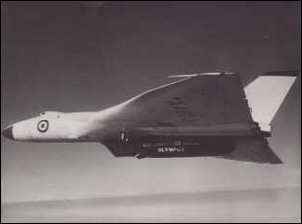
![]() 'The Vulcan was found to be ideally suited to
the role of FTB. Its considerable ground clearance made the job of fitting
the test engine relatively straightforward, and its flight performance was
more than adequate for the initial flight trials of the supersonic
powerplant. The conversion took two years, the first flight, which was
captained by Tom Frost, Bristol Siddeley's Chief Test Pilot, occurring on
9th September 1966 after some weeks of ground running. Strenuous efforts
had been made to get the aircraft ready in time to be demonstrated at the
SBAC Show at Farnborough, but the first flight did not occur until the
Thursday of Farnborough week. With only four flying days left. Clearly the
flying qualities of the aircraft with the somewhat rectangular nacelle
underneath had to be checked for safety and controllability before the
aircraft could appear at the show, and tests to check these items were
scheduled for the first two flights. As can be imagined, considerable
discussion had taken place to decide on the minimum level of testing
consonant with safety to clear the installation for Farnborough, and to
simplify the exercise, it was decided not to operate the test engine in
flight until after the show.
'The Vulcan was found to be ideally suited to
the role of FTB. Its considerable ground clearance made the job of fitting
the test engine relatively straightforward, and its flight performance was
more than adequate for the initial flight trials of the supersonic
powerplant. The conversion took two years, the first flight, which was
captained by Tom Frost, Bristol Siddeley's Chief Test Pilot, occurring on
9th September 1966 after some weeks of ground running. Strenuous efforts
had been made to get the aircraft ready in time to be demonstrated at the
SBAC Show at Farnborough, but the first flight did not occur until the
Thursday of Farnborough week. With only four flying days left. Clearly the
flying qualities of the aircraft with the somewhat rectangular nacelle
underneath had to be checked for safety and controllability before the
aircraft could appear at the show, and tests to check these items were
scheduled for the first two flights. As can be imagined, considerable
discussion had taken place to decide on the minimum level of testing
consonant with safety to clear the installation for Farnborough, and to
simplify the exercise, it was decided not to operate the test engine in
flight until after the show. 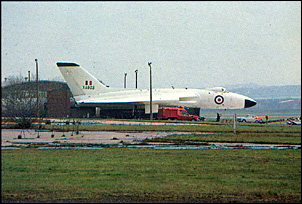
![]() 'The difficulties of abandoning a Vulcan
from the rear cabin were well known, as in approximately half of the
Vulcans lost in flying accidents the rear crew had not escaped. It was
therefore considered essential that escape drills were practised by all
rear crew at least once a year, under as realistic conditions as possible.
To achieve this, the aircraft was taken off flying status, and mounted on
jacks with the under carriage retracted. The undercarriage was raised to
simulate the most likely configuration for abandoning the aircraft. The
possibility of successfully escaping with the nose leg down was
theoretically possible, but in my opinion would have been extremely
marginal in practice. The complete crew, all wearing flying kit, would
strap in, and a wide variety of escape drills would be practised, ranging
from complete crew abandonment on the ground. Because people tended to
come out of the aircraft fairly fast, thick mattresses were liberally
strewn around to minimise the risk of injury.
'The difficulties of abandoning a Vulcan
from the rear cabin were well known, as in approximately half of the
Vulcans lost in flying accidents the rear crew had not escaped. It was
therefore considered essential that escape drills were practised by all
rear crew at least once a year, under as realistic conditions as possible.
To achieve this, the aircraft was taken off flying status, and mounted on
jacks with the under carriage retracted. The undercarriage was raised to
simulate the most likely configuration for abandoning the aircraft. The
possibility of successfully escaping with the nose leg down was
theoretically possible, but in my opinion would have been extremely
marginal in practice. The complete crew, all wearing flying kit, would
strap in, and a wide variety of escape drills would be practised, ranging
from complete crew abandonment on the ground. Because people tended to
come out of the aircraft fairly fast, thick mattresses were liberally
strewn around to minimise the risk of injury. 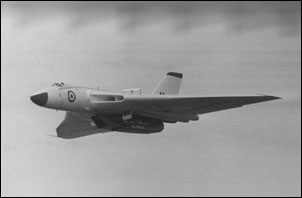
![]() 'Very few airframe problems surfaced during
the programme, potentially the worst occurring in 6th February 1970 on
flight 167, when a hydraulic pipe fractured after two hours of low
altitude flyovers at Filton. A total loss of hydraulic fluid ensued, and
as the emergency power pack simply pumped the reserve fluid out through
the same fracture, it also caused a total loss of hydraulic pressure. On a
Mark 1 Vulcan the undercarriage and wheel brake anti-skid systems
(Maxaret) are operated by hydraulic pressure. Without the Maxarets a long
runway is required in order to avoid overheating the brakes, so the
aircraft was diverted to A&AEE Boscombe Down, only to find that the
airfield was closed, it being after 1600 hours on a Friday. A further
diversion to RAF Fairford then took place, the undercarriage being lowered
under freefall conditions, but the nose leg failed to lock down, and
remained only partially lowered. On landing, the nose leg did finally lock
down after the main legs were firmly on the runway, at less than 100
knots, when presumably the aerodynamic loads on the nose leg had dropped
to a sufficiently low value. The braking parachute also failed to stream,
and the subsequently heavy wheel braking, made without the benefit of the
anti-skid system, resulted in a port brake fire. The final landing was
made with all the fuel low level warning lights on. After landing the
underside of the aircraft was covered in blood-red hydraulic fluid.
'Very few airframe problems surfaced during
the programme, potentially the worst occurring in 6th February 1970 on
flight 167, when a hydraulic pipe fractured after two hours of low
altitude flyovers at Filton. A total loss of hydraulic fluid ensued, and
as the emergency power pack simply pumped the reserve fluid out through
the same fracture, it also caused a total loss of hydraulic pressure. On a
Mark 1 Vulcan the undercarriage and wheel brake anti-skid systems
(Maxaret) are operated by hydraulic pressure. Without the Maxarets a long
runway is required in order to avoid overheating the brakes, so the
aircraft was diverted to A&AEE Boscombe Down, only to find that the
airfield was closed, it being after 1600 hours on a Friday. A further
diversion to RAF Fairford then took place, the undercarriage being lowered
under freefall conditions, but the nose leg failed to lock down, and
remained only partially lowered. On landing, the nose leg did finally lock
down after the main legs were firmly on the runway, at less than 100
knots, when presumably the aerodynamic loads on the nose leg had dropped
to a sufficiently low value. The braking parachute also failed to stream,
and the subsequently heavy wheel braking, made without the benefit of the
anti-skid system, resulted in a port brake fire. The final landing was
made with all the fuel low level warning lights on. After landing the
underside of the aircraft was covered in blood-red hydraulic fluid.
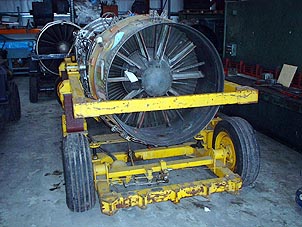
![]() 'A further dummy drop trial took place on
12th March 1971, after the water spray grid has been fitted for the
de-icing trials. Again, no effect on escape trajectories was noted. The
de-icing trials was one of the more important tasks carried out by XA903.
A water spray grid containing over a hundred nozzles was mounted ahead of
the Olympus 593 air intake, and water was sprayed into the engine at
varying concentrations with the intake de-icing system in operation. The
ice built up around the intake, and the way in which it was removed by the
de-icing system, was monitored by a series of television cameras. The
variable not under the control of the test crew was ambient air
temperature, and the Meteorological Office was of great help in predicting
where the desired air temperatures could be found. The programme was
extremely successful, so much so that a Special Category icing clearance
for Concorde was issued, based entirely on the Vulcan results.
'A further dummy drop trial took place on
12th March 1971, after the water spray grid has been fitted for the
de-icing trials. Again, no effect on escape trajectories was noted. The
de-icing trials was one of the more important tasks carried out by XA903.
A water spray grid containing over a hundred nozzles was mounted ahead of
the Olympus 593 air intake, and water was sprayed into the engine at
varying concentrations with the intake de-icing system in operation. The
ice built up around the intake, and the way in which it was removed by the
de-icing system, was monitored by a series of television cameras. The
variable not under the control of the test crew was ambient air
temperature, and the Meteorological Office was of great help in predicting
where the desired air temperatures could be found. The programme was
extremely successful, so much so that a Special Category icing clearance
for Concorde was issued, based entirely on the Vulcan results.